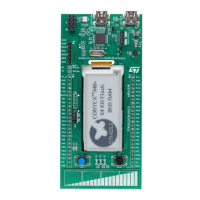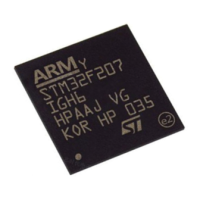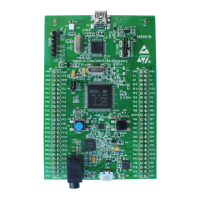PM0215 About this document
Doc ID 022979 Rev 1 9/91
1.3 About the STM32 Cortex-M0 processor and core peripherals
The Cortex-M0 processor is an entry-level 32-bit ARM Cortex processor designed for a
broad range of embedded applications. It offers significant benefits to developers, including:
● a simple architecture that is easy to learn and program
● ultra-low power, energy efficient operation
● excellent code density
● deterministic, high-performance interrupt handling
● upward compatibility with Cortex-M processor family.
The Cortex-M0 processor is built on a highly area and power optimized 32-bit processor
core, with a 3-stage pipeline von Neumann architecture. The processor delivers exceptional
energy efficiency through a small but powerful instruction set and extensively optimized
design, providing high-end processing hardware including a single-cycle multiplier.
The Cortex-M0 processor implements the ARMv6-M architecture, which is based on the 16-
bit Thumb® instruction set and includes Thumb-2 technology. This provides the exceptional
performance expected of a modern 32-bit architecture, with a higher code density than other
8-bit and 16-bit microcontrollers.
Figure 1. STM32 Cortex-M0 implementation
The Cortex-M0 processor closely integrates a configurable nested vectored interrupt
controller (NVIC), to deliver industry-leading interrupt performance. The NVIC:
● includes a non-maskable interrupt (NMI)
● provides zero jitter interrupt option
● provides four interrupt priority levels.
The tight integration of the processor core and NVIC provides fast execution of interrupt
service routines (ISRs), dramatically reducing the interrupt latency. This is achieved through
the hardware stacking of registers, and the ability to abandon and restart load-multiple and
store-multiple operations. Interrupt handlers do not require any assembler wrapper code,
removing any code overhead from the ISRs. Tail-chaining optimization also significantly
reduces the overhead when switching from one ISR to another. To optimize low-power
designs, the NVIC integrates with the sleep modes, including a deep sleep function that
enables the entire device to be rapidly powered down.
&RUWH[0SURFHVVRU
&RUWH[0
SURFHVVRU
FRUH
%XVPDWUL[
1HVWHG
9HFWRUHG
,QWHUUXSW
&RQWUROOHU
19,&
,QWHUUXSWV
'HEXJ
$FFHVV3RUW
'$3
$+%/LWHLQWHUIDFHWRV\VWHP 6HULDO:LUH
'HEXJ
'HEXJJHU
LQWHUIDFH
%UHDNSRLQW
DQG
ZDWFKSRLQW
XQLW
&RUWH[0FRPSRQHQWV
069

